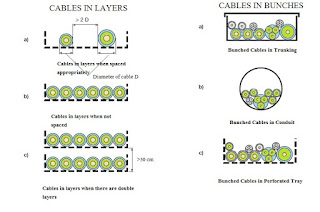Designing a plant; Reduction factors while laying cables in bunches and layers

There are following procedure to be adopted for correct dimensioning of a plant (i) Load Analysis:- First step in dimensioning of a plant is to check for connected load and their location Now check for location of power distribution panels Now we can calculate cable requirement i.e. length of cables and path of cable laying Now we will do calculations of total power consumption while taking account utilization factors and demand factors (ii) Transformer and generator size calculations:- Transformer and generator size are usually selected 15-30% more in comparison to total connected load considering future prospectus. (iii) Conductor size selection - Now we calculate cable size according to load requirement of various connected loads. Cable selected may be copper or aluminum. Cables sel...


